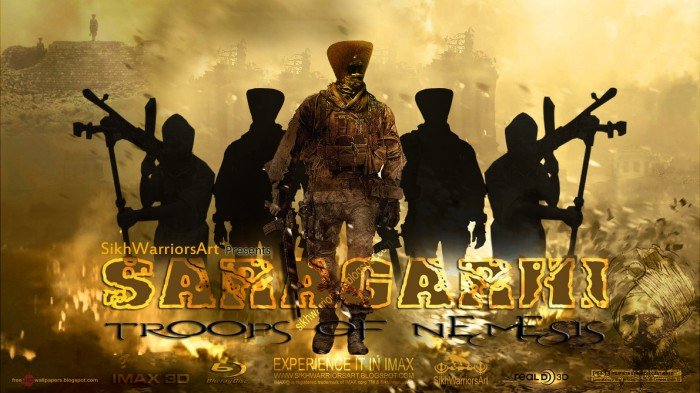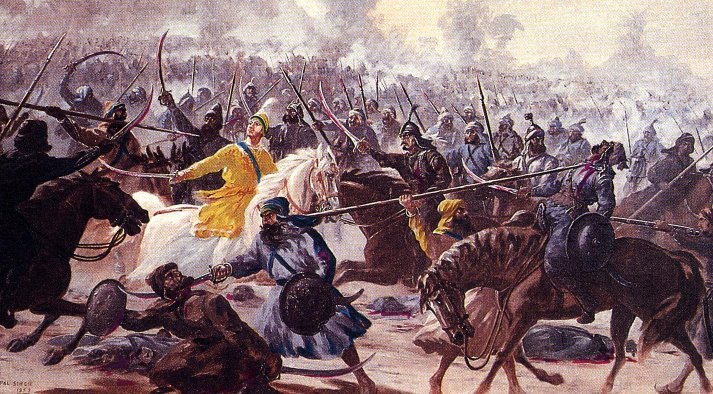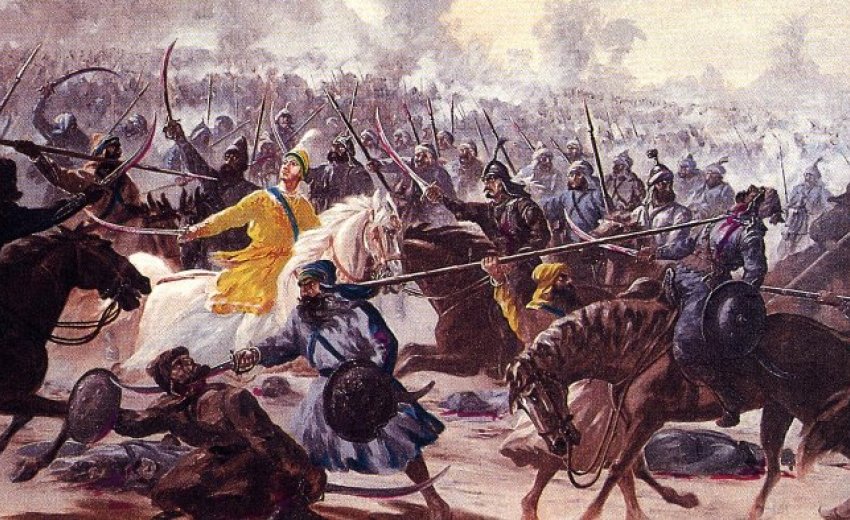In an article IJ Singh remarks why the battles the Guru Ji fought never became as famous as SARAGARHI. Although these battles were far greater than Saragarhi, the Sikh nation is to be blamed for not making these heroic battles known to the world and shared.

The battle of Saragarhi would have gone un-noticed if not for the British. It was due to the salutations paid by Queen Victoria and her parliament, echoed the tribute to the 21 Sikh soldiers, that a record was established. Years later we are able to use this record to make Saragarhi known to the world.
If left to the Sikhs, it would have probably been not heard by Sikhs themselves today.
The battle of Saragarhi is one of heroics, of the 20th century studied by many Military Schools the world over, and acknowledged by UN as one of the greatest test of times for men fighting an enemy running in their thousands, like the 21 Sikhs at Saragarhi.
The battle of Chamkaur on the 7th of December, 1705 resembles a scene, like Saragarhi, but with greater conviction and electrifying energy of sprituality, led personally by the 10th Master of the Sikh nation, Guru Gobind Singh, the master of the blue and magnificence.
After having accepted the offer to evacuate Anandpur Sahib, Guru Gobind Singh Ji along with some of Sikhs, reached Chamkaur. A zamindar asks the Guru Ji to stay in his house, a mud built house. It was this mud house that was to be fortified, and known as chamkaur di kachi garhi, when the traitorous Mughals pursued the Guru ji, having broken their promise for peaceful passage.
 The Mughals surrounded the mud house. It was the 7th of december, 1705, when the Battle of Chamkaur was fought, by few Sikhs against hundreds of thousands of Mughals.
The Mughals surrounded the mud house. It was the 7th of december, 1705, when the Battle of Chamkaur was fought, by few Sikhs against hundreds of thousands of Mughals.
A battle very rare, the rarest of heroism, surpassing all odds of defeat was fought heroically, to end in the commencement of the destruction of the Mughal empire in the years to come. Never had so few, stood to so many, before that in history of mankind in the Indian subcontinent. Never had so few with strong faith among themselves stood tall against so many thousands facing them. Never had so few, standing in a mud fortified position, inflicted the death so many Mughals, openly and daringly. Never has so many Mughals been slain before by the few Sikhs - 40 in all, standing against the mighty Mughal army of several thousands - with a conviction in the TRUTH, honesty and ever glorious Chardhi Kala - ever inspiring state of mind- against the despondent and tired out army of Mughal hordes. Never was the mud structure surrendered by these heroes of Sikh nation. At the end of the day long battle, as Five Sikhs and Guru Ji still stood tall and with such defiance, that panic set among the mughals.
After having killed several thousands, they could not claim victory over the Guru, as he stood watching red eyed and magnificently the scene of the battle field, and reassuring his dying Sikh warriors the charisma and valour of the stand for TRUTH and Freedom of the Indian people.
The battle had raged for three quarters of a day, wherein spears and arrows and swords were used. The Guru had used military precision with such effectiveness, that his deployment of Sikhs, could repulse the enemy attack from any side.
Volleys after volley of arrows was discharged from the mud fortification, and the same hit the enemy with such accuracy, that enemy soldier after soldier fell. Yet the volley discharged by the enemy could not hit the Sikhs, who had used good cover of the hut. Many hundreds of Mughals lay dead.
When the day was about to be over, the Sikhs found their stock of ammunition and missiles along with water was depleting, a decision was made to engage the enemy in hand to hand combat.
The Sikhs then came out in twos, gave a tough fight before becoming martyrs. AS one group fell, another group of two would emerge from another direction, surprising the enemy and attacking before the enemy had time to recover from the fight. In these groups, the two older Sahibzade of Guru Gobind Singh, one 15 years old, another 19 years old also came out and fought like enraged lions, out for a kill. Which father could sent his sons to an assured death of a martyr - for the cause of the TRUTH & RIGHTEOUSNESS.
The Guru Ji made no distinction between His Sons and His Sikhs. When asked by one Sikhs, Guru JI why, why are you sending these Priceless Princes, the Guru Ji smilingly replied....millions more of sons will thrive and live, don't worry.
The Guru ji displayed he had the capacity to sacrifice everything for his warrior Sikhs. He had a noble cause for the rights and freedom of the oppressed Indian people.
All noble and honest historians writing about this battle agree that every Sikh who participated in this battle knew, there was to be only ONE end at the end. They fought viciously and heroically. Their spirit, valour and steadfastness was marvelously shown, and beyond measurable heroism, as known to men.
A great feat of warfare was exhibited, they fought till the LAST BREATH, that kept them alive till then. The sons of the Gurus fought with such bravery that many of the enemy were cut to ground, before they went down more than human heroes could do.

Sainapat, writes, that Sahibzada Jhujar Singh made such a terribly lightening attack upon the enemy, with such vigorous determination, that it became impossible for hundreds of the enemy to locate his position, as many fell to his sword.
Apart from that, the Bhat vahis give another good source of information.
A number of poets have written poems on this episode, particularly about the two sons of the Guru Sahib.
Poet Nandlal Nurpuri wrote a blood raising lyric, "chum chum rakho ni ih kalgi jhujar di". It became so famous that many would sing this.
A Moslem Poet Alah Yaar Khan, wrote a memorable poetry, wherein displayed the valor of the young sons of Guru Ji so poignantly narrated and the same was recited by him in the early quarter of last century. Says he, there is no place more pious than the place where the two young ones became martyrs.
When the battle came to a close at night, still FIVE Sikhs were left with the Guru ji out of 40. The Sikhs decided that Guru Ji should leave to take on the fight for another day. The Guru Ji had invested power into the hands of Five Sikhs, so he had to obey their command.
SO a decision was made to leave that mud fort. During the night, Bhai Daya Singh ji and Bhai Dharam Singh ji (two of the original Panj Piare) along with Bhai Maan Singh ji and other Singhs remained in the fort of Chamkaur Sahib. There were a total of 5 Singhs left.
Now the Guru-roop Panj Piarey (Five Singhs) gave Hukam to Guru Sahib to leave the fort. Guru Sahib did not leave quietly. On leaving, Guru Sahib blew his horn and stood on high ground and clapped his hands three times saying “Peeré Hind Rahaavat” (“The "Peer" of India is Leaving”).
The enemy forces were gripped with fear hearing his cry! So openly, and brazenly, He departed, through the enemy camp that, with another cry from the fortified hut, the enemy was frozen, and did not make any move, and the Guru ji left towards Macchiwarra.
This was a battle fought with no less courage than Saragarhi, but we Sikhs have done injustice to both our own history and our Guru.
While Christians proudly tell the world of One Shahid, the Saviour Jesus, we Sikhs cannot finish counting OUR shahids, yet we have NEVER told the world, even of one. In such, we have not even told our own young! What a travesty of truth, denied, hidden and unrecognized by our own!
ਸੂਰਾ ਸੋ ਪਹਿਚਾਨੀਐ ਜੁ ਲਰੈ ਦੀਨ ਕੇ ਹੇਤ ॥
sooraa so pahichaanee-ai, jo larai deen ke het.
That person alone is known as a spiritual warrior, who fights in defence of religion.
ਪੁਰਜਾ ਪੁਰਜਾ ਕਟਿ ਮਰੈ ਕਬਹੂ ਨ ਛਾਡੈ ਖੇਤੁ ॥੨॥੨॥
purjaa purjaa katt marai, kabhoo na chhaadai khet. 22.
They may be cut apart, piece by piece, but they never leave the field of battle. 22.
(Ang 1105, SGGS)
This was the sign of a true warrior! By the time Baba Jujhar Singh ji had attained Shaheedi nightfall had arrived and the moon could be seen in the sky. Guru Sahib wrote in his composition, the Zafarnama:
ਚਿ ਕਸਮੇ ਕੁਰਾਂ ਮਨ ਕੁਨਮ ਏਤਬਾਰ
ਵਗਰਨਾ ਤੁ ਗੋਈ ਮਨ ਈਂ ਰਾਹਚਿਕਾਰ
che kasm-e kuraa(n), man kunam eitbaar
vagarnaa tu goee, man ee(n) raah chi-kaar
What trust can I have on your oath on Koran?
Otherwise, why should I have taken this path (of taking up the sword)?
(Line 23, Zafarnama)
ਧੰਨ ਉਹ ਧਰਤੀ ਧੰਨ ਉਹ ਬਾਪੂ, ਧੰਨ ਵਡਭਾਗੀ ਮਾਈ ।
ਢੰਗ ਜਿਉਣ ਦਾ ਜਿਸਦਾ ਪੁੱਤਰ, ਦੱਸ ਗਿਆ ਸਦੀਆ ਸਾਈਂ ।
“Blessed is that land, blessed is that father, blessed is the great mother.
Whose son has shown the way to live, for centuries to come.”
